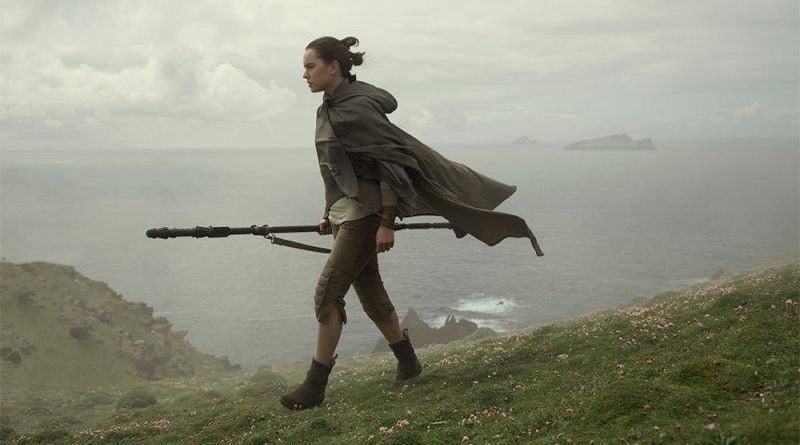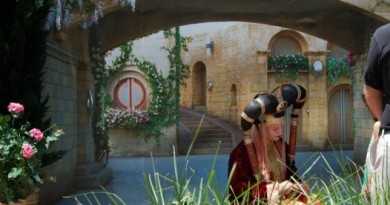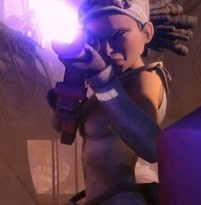Rey At Risk Revisited: The Danger Signs From The Last Jedi
After the release of The Force Awakens, Rey immediately took her place as one of the top-tier fan-favorite characters in the Star Wars franchise. Fans young and old, newfound and longstanding, found a heroine they could believe in and root for. Two years later, her popularity with the fans remains strong.
Rey’s prospects within the story, on the other hand, are more clouded. In February 2016, our post Rey At Risk: Keeping Lucasfilm Accountable to Her Potential explained our primary areas of concern for how the franchise – which has a less-than-stellar track record, spanning four decades, in concluding the tales of its prominent female characters – might let down Rey and her fans. We focused on three topics: the story told in The Force Awakens, the marketing of Rey and the movie, and the possibility that Rey’s hidden heritage could result in her role becoming subservient to the culmination of Kylo Ren’s arc in the Skywalker family saga. We concluded by emphasizing the importance of fans speaking up – for themselves and for Rey – to keep Lucasfilm accountable for how Rey’s story finishes.
Unfortunately, the release of The Last Jedi did not diminish these concerns. In some regards, in fact, the risks for Rey in Episode IX are even greater in light of The Last Jedi than they were after The Force Awakens alone.
The good news is that Episode IX is still being written, and will not enter principal photography until the summer of 2018. Moreover, with Lucasfilm’s proven willingness to undertake reshoots – sometimes very extensive and very expensive reshoots – on three of its last four Star Wars films, plenty of time remains to ensure Episode IX does right by Rey. For that reason, it is important to revisit the reasons Rey’s story is at risk now, while fans still have enough time to speak up before Episode IX seals her fate.
Rey’s Declining Role in the Trilogy’s Story
On first impression, The Last Jedi might appear to fit the middle-movie precedent for a Star Wars trilogy: advancing the Jedi protagonist’s character arc without concluding it. After her origin story Hero’s Journey in The Force Awakens, taking her from lonely Jakku scavenger to magical heroine wielding a lightsaber against Kylo Ren, in The Last Jedi Rey undertakes a second heroic cycle that brings her from fledgling Force user to rightfully bearing the title as the last Jedi. Her training with Luke, such as it is, has ended and she stands ready to help the Resistance defeat the First Order in the third film.
As Rose tells Finn, though, “Look closer.”
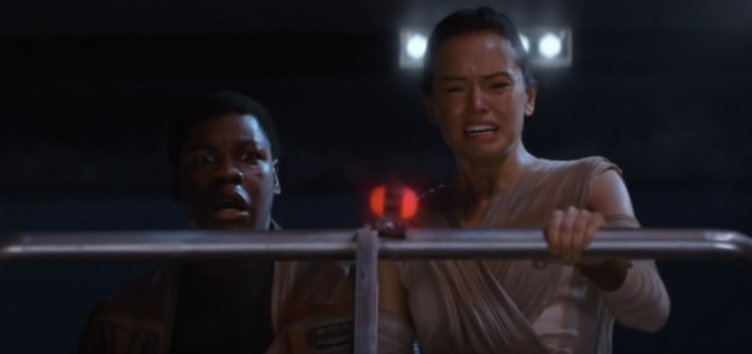 In The Force Awakens, Rey is a vibrant and kinetic character whose story is always in motion – until the showdown between Han Solo and Kylo Ren on a gangway inside Starkiller Base’s oscillator facility. Suddenly Rey is passive, standing in place and observing. Even though she knows how dangerous Kylo Ren is – the villain has invaded her mind twice, held her captive, and insulted her friends as traitors and criminals – she takes no action to stop him. This abrupt sidelining of Rey to serve Kylo’s story becomes less noticeable, though, because it quickly transitions into the showdown in the snowy forest, where the Skywalker lightsaber flies into Rey’s hand and she draws upon the guidance of the Force to defeat him.
In The Force Awakens, Rey is a vibrant and kinetic character whose story is always in motion – until the showdown between Han Solo and Kylo Ren on a gangway inside Starkiller Base’s oscillator facility. Suddenly Rey is passive, standing in place and observing. Even though she knows how dangerous Kylo Ren is – the villain has invaded her mind twice, held her captive, and insulted her friends as traitors and criminals – she takes no action to stop him. This abrupt sidelining of Rey to serve Kylo’s story becomes less noticeable, though, because it quickly transitions into the showdown in the snowy forest, where the Skywalker lightsaber flies into Rey’s hand and she draws upon the guidance of the Force to defeat him.
In The Last Jedi, Rey is sidelined again – this time for a much longer segment of the movie, and during its final climactic events. Rey and Kylo have a second faceoff, but it occurs earlier in the film in the throne room on the Supremacy. Kylo rejects Rey’s offer to return to the light; Rey rejects his plea to join him in darkness. Functionally, this is the end of the third act in a traditional Star Wars film, but The Last Jedi has four acts: the entire sequence on Crait remains, and Rey has no role to play in the emotional throughline of those events. From the moment the lightsaber splits in two on the Supremacy until the Resistance escapes through the base’s natural tunnels, Rey only appears fleetingly aboard the Falcon. Everything else in the memorable Crait sequence – the Resistance hunkering down, Finn and Rose arriving, the First Order’s landing, the ski speeder flight and retreat, Luke’s farewell to Leia and march outward past the Resistance fighters, the showdown between Kylo and Luke, the reveal of Luke’s astral projection – has no role for Rey to play. It is a climax between the Resistance and the First Order, and between Luke and his fallen apprentice.
Only after Luke’s diversion has worked, distracting Kylo long enough for the Resistance survivors to make it through the tunnels, is Rey permitted to reenter the story. She lifts the rocks, is pronounced by Luke to be the last Jedi, feels Luke’s death in the Force, and shuts the door on Kylo Ren to end their brief bond through the Force. These actions, though, are essentially epilogue. It already was clear from her choice on the Supremacy that Rey is a Jedi in opposition to Kylo; an anointing by Luke and a literal metaphor with Kylo merely reaffirm it. Rey also appears in the movie’s structural epilogue to glance at Finn, greet Poe, and share a brief moment with Leia. None of this, though, advances her arc: her character development in The Last Jedi ends on the Supremacy.
 If Rey is meant to be the Jedi protagonist of the Sequel Trilogy, this massive sidelining of her role in the climax of The Last Jedi is a major misstep. It certainly has no precedent in any previous Star Wars film: Luke flew in the Battle of Yavin, fought Darth Vader on Cloud City, and faced down two Sith Lords on the second Death Star; Anakin flew in the Battle of Naboo, fought in the arena and against Count Dooku on Geonosis, and dueled his former master on Mustafar. Even Rey herself in The Force Awakens has her duel with Kylo in the forest intercut with Poe’s destruction of the oscillator.
If Rey is meant to be the Jedi protagonist of the Sequel Trilogy, this massive sidelining of her role in the climax of The Last Jedi is a major misstep. It certainly has no precedent in any previous Star Wars film: Luke flew in the Battle of Yavin, fought Darth Vader on Cloud City, and faced down two Sith Lords on the second Death Star; Anakin flew in the Battle of Naboo, fought in the arena and against Count Dooku on Geonosis, and dueled his former master on Mustafar. Even Rey herself in The Force Awakens has her duel with Kylo in the forest intercut with Poe’s destruction of the oscillator.
For The Last Jedi to allow Rey to all but disappear from the movie for nearly twenty minutes of the climax – so that the story can focus instead Kylo Ren and his final showdown with Luke Skywalker – strongly suggests that the Sequel Trilogy is not her story.
And it is more than simply the climax of The Last Jedi that presents this implication: the remainder of the movie does, too.
In The Force Awakens, at least, Rey is the protagonist of the film on a Hero’s Journey comparable to Luke’s in A New Hope. The movie’s plot is a throughline for Rey. The opening scene sends BB-8 toward her, just as Leia sends the droids toward Luke. The rest of the story follows Rey’s path from Jakku to Han to Takodana to Starkiller Base, and finally to D’Qar before her epilogue’s travel to Ahch-To.
The Last Jedi, on the other hand, is not Rey’s story: while she is undoubtedly an important character, the movie is an ensemble story. The Art of The Last Jedi confirms that writer-director Rian Johnson designed the film around three “triangles” centered respectively on Rey, Luke, and Kylo Ren; Finn, Rose, and DJ; and Poe, Leia, and Holdo. After the opening act leans heavily on Poe, Rey is featured prominently in the middle of the film – from when her training with Luke and ForceTimes with Kylo begin through the events on the Supremacy, contemporaneous with Finn and Rose going to Canto Bight and Poe’s conflict with Holdo in Leia’s absence – but in the final act on Crait she is cut out from her own triangle to allow Luke and Kylo to take center stage for the film’s finale. Unlike Luke in the Original Trilogy or Anakin in the Prequel Trilogy, Rey is offscreen for substantially more time in The Last Jedi while the film develops two other subplots.
 In further contrast to previous Star Wars films, these other subplots do not interrelate back to Rey’s the way they do with Luke’s and Anakin’s. In The Empire Strikes Back, the Han/Leia subplot brings them to Bespin, where they serve as bait to draw Luke to Vader; in Return of the Jedi, the Rebel mission to the forest moon of Endor and the second Death Star is a trap laid not only to destroy the Rebellion, but to lure Luke to the dark side, as well. In Attack of the Clones, Obi-Wan’s investigation of the Kaminoan saberdart keeps him away from Anakin and Padmé to enable their love story to blossom, then brings them to Geonosis to try to rescue him; in Revenge of the Sith, Obi-Wan’s pursuit of Grievous again separates him from Anakin, this time to enable seduction to the dark side by Darth Sidious, before reuniting them for the fateful duel on Mustafar. In The Last Jedi, on the other hand, neither Finn’s nor Poe’s subplots have any effect on Rey’s story. Her choices are motivated entirely by Luke and Kylo. Even her plea for “Ben” to command the First Order to stop firing upon the Resistance transports is as much about urging him to choose the light as it is about saving her friends. And when she does arrive at Crait to save Finn and Poe, first with the ski speeders and then with the rocks, it is only after her mission to the Supremacy has failed to redeem Kylo. The story does not compel Rey to make any difficult choice among conflicting alternatives, such as Luke leaving Dagobah before his training is complete or Anakin disobeying orders to go help Obi-Wan on Geonosis.
In further contrast to previous Star Wars films, these other subplots do not interrelate back to Rey’s the way they do with Luke’s and Anakin’s. In The Empire Strikes Back, the Han/Leia subplot brings them to Bespin, where they serve as bait to draw Luke to Vader; in Return of the Jedi, the Rebel mission to the forest moon of Endor and the second Death Star is a trap laid not only to destroy the Rebellion, but to lure Luke to the dark side, as well. In Attack of the Clones, Obi-Wan’s investigation of the Kaminoan saberdart keeps him away from Anakin and Padmé to enable their love story to blossom, then brings them to Geonosis to try to rescue him; in Revenge of the Sith, Obi-Wan’s pursuit of Grievous again separates him from Anakin, this time to enable seduction to the dark side by Darth Sidious, before reuniting them for the fateful duel on Mustafar. In The Last Jedi, on the other hand, neither Finn’s nor Poe’s subplots have any effect on Rey’s story. Her choices are motivated entirely by Luke and Kylo. Even her plea for “Ben” to command the First Order to stop firing upon the Resistance transports is as much about urging him to choose the light as it is about saving her friends. And when she does arrive at Crait to save Finn and Poe, first with the ski speeders and then with the rocks, it is only after her mission to the Supremacy has failed to redeem Kylo. The story does not compel Rey to make any difficult choice among conflicting alternatives, such as Luke leaving Dagobah before his training is complete or Anakin disobeying orders to go help Obi-Wan on Geonosis.
Even more troubling, Rey has no meaningful agency in the direction of her triangle’s subplot in The Last Jedi. Rey first puts her faith in Luke. When he lets her down, she puts her faith in “Ben.” When he too lets her down, Rey returns to her friends – not because she chooses to, but because she has no other option left. Only once does Rey partially influence Luke’s motivation: her persistence in following him around and her candor in the tree library contribute to his vulnerability to Artoo’s “cheap move” in playing Leia’s hologram plea, after which Luke finally agrees to teach Rey three lessons about the Force. Everything else Luke does in the film comes from his past failures with Kylo and his current failures of himself. And it is Yoda, not Rey, who teaches Luke his final lesson about failure and overcoming it. Likewise, Rey does not influence Kylo’s choices, either. During their ForceTimes he first tries to use the Force to compel her to bring Luke to him, then uses the tragic night in the training temple to seed doubts about Luke, and finally exploits her loneliness after the Mirror Cave to lure her to the Supremacy, where he uses her presence as distraction to finally kill Snoke and seize the throne of the First Order for himself. It is difficult to see Rey as the pivotal character in her own “triangle” when she has such little impact on the other two characters – who proceed to face off on Crait without her.
 External sources beyond the movie itself confirm that Johnson did not center Rey in the story while creating it. In People Magazine in early January, for example, Johnson admitted that Rey’s storyline was defined in reference to Kylo Ren:
External sources beyond the movie itself confirm that Johnson did not center Rey in the story while creating it. In People Magazine in early January, for example, Johnson admitted that Rey’s storyline was defined in reference to Kylo Ren:
“I thought that the hardest thing that Rey could possibly be faced with is being forced to talk to this person that she completely despises. And also the audience, we hate him coming into it. She had to be our proxy and so that’s why in those first few conversations, she is just spitting in his face.”
Later that month on the /Filmcast podcast, Johnson went further, conceding on the record that the Sequel Trilogy filmmakers had no determined plan for Rey’s heritage from the beginning and were making it up as they went along:
“I honestly listed everything I could think of. Even awful possibilities where I said, ‘This is not what we’re going to do.’ I mean the less silly one was, ‘Is she a clone?’ Anything that’s a theory on Reddit now I guarantee was listed on that document. … The silliest one was, ‘Is she a robot?’ Okay, we’ve seen a biomechanical realistic flesh hand on Luke, could the technology have advanced significantly in the 30 years, and then I just started laughing. Look forward to the ‘Rey was almost a robot’ headlines.”
It is well known, of course, that George Lucas was making it up as he went along, too, during the productions of the Original Trilogy and Prequel Trilogy. Both of those situations are entirely different from Rey in the current trilogy, however. When Lucas made the original Star Wars, he had broader notions but no guarantee of a sequel, much less a trilogy. Developments like Vader as Luke’s father in Episode V and retcons like Leia as Luke’s sister in Episode VI are natural in such a process. (The animated series The Clone Wars faced similar revisions and changes in direction, also as a function of Lucas overseeing the writing of most of its seasons with no fixed total number of episodes in mind.) For the Prequels, Lucas knew he was writing a trilogy from the beginning and had a strong sense of the arc of its central character: Anakin would be a good boy in Episode I, a troubled adolescent in Episode II, and a tragic figure in Episode III. The arcs for Obi-Wan and Padmé had less clarity and were constructed around Anakin’s, resulting in ill-advised decisions such as key portions of Padmé’s arcs in Episode II and Episode III ending up on the cutting room floor to allow for longer action sequences.
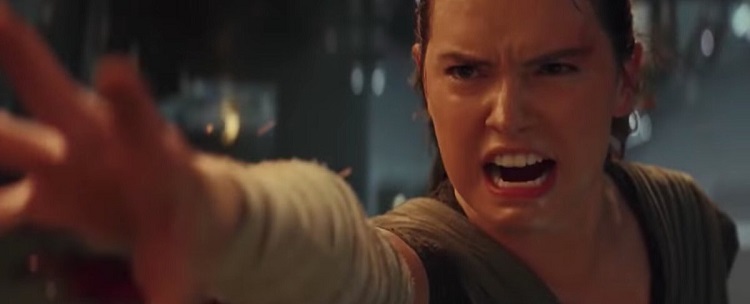 Like the Prequels, the Sequel Trilogy was greenlit as a series of three films from its inception. Unlike Lucas’ work, though, the Sequel Trilogy has no master vision or singular influential voice in its creation. If the second film could be written without a fact so basic as Rey’s identity decided upon, it is a dubious suggestion at best that she is the trilogy’s central character. More likely, the new-generation central character is the one clearly defined in the story: Kylo Ren, the son of Han and Leia and the nephew of Luke.
Like the Prequels, the Sequel Trilogy was greenlit as a series of three films from its inception. Unlike Lucas’ work, though, the Sequel Trilogy has no master vision or singular influential voice in its creation. If the second film could be written without a fact so basic as Rey’s identity decided upon, it is a dubious suggestion at best that she is the trilogy’s central character. More likely, the new-generation central character is the one clearly defined in the story: Kylo Ren, the son of Han and Leia and the nephew of Luke.
Based on the plot structure and characters arcs in The Last Jedi, and the role that the principal characters play in juxtaposition to one another in The Force Awakens and The Last Jedi, the emotional throughline of the Sequel Trilogy appears to be the Skywalker family saga, resolving the stories of Han, Luke, Leia, and Kylo. If that is the story being told, then Rey is not participant in the family saga but an adjunct character like Obi-Wan Kenobi, a Jedi heroine outsider to balance against a Skywalker villain family member. If this turns out to be the case, Rey may be an important character in the Sequel Trilogy, but it will not be her story.
What does this mean for Episode IX? Nothing for certain, but it does indicate clearly that the risks to Rey’s story are high. We know what remains for Kylo: he must either stay committed to the dark and be defeated, or find his way back to the light on his own. And his fate will determine the legacy of the Skywalker family in the galaxy, too.
But what emotional arc remains for Rey’s character development? She already has experienced her Return of the Jedi moment on the Supremacy, standing firm in the light to reject Kylo’s offer. As a matter of plot, in Episode IX she could further develop a new order of Jedi and help the Resistance topple the First Order’s tyranny. But what inner conflict is built into the story that she must confront and resolve? The simple fact that this question can even be asked demonstrates how much Lucasfilm’s storytelling in the Sequel Trilogy already has failed Rey.
The Marketing Disconnect Continues
In the lead-up to The Force Awakens, the marketing of the film assiduously avoided any hint that Rey was the Jedi heroine of the story. Even though the origin story of a female Jedi was the earliest initial premise for Michael Arndt’s development of the story based on George Lucas’ treatment, and even though Ahsoka Tano’s popularity after six seasons of The Clone Wars had proven the fandom was ready for it, Lucasfilm nevertheless treated the notion that a girl could be the main hero as a fundamental plot twist in the film on par with Han’s death. The trailers, promotional art, toys, and merchandise released prior to and shortly after the movie never showed Rey use the Force or hold the lightsaber – to the point that they often highlighted Finn holding the Skywalker blade, creating a deliberate false implication that betrayed the expectations of fans who rightly believed they were about to see the first lead Jedi character played by a person of color. Two years ago we questioned whether this marketing truly was a function of “mystery box” secret-keeping about Rey, or instead if the focus on Kylo Ren in The Force Awakens marketing reflected the truth: that the Sequel Trilogy is his story, not hers, because he is the next-generation Skywalker in the Skywalker saga.
Having watched Rey build a large fanbase after the first film, Lucasfilm responded by featuring Rey – holding the ignited Skywalker lightsaber – prominently in the marketing for The Last Jedi. But the distractions and diversions continued.
The action figures featuring her new attire in the film, for the sequences on the Supremacy and Crait, was labeled as “Rey (Jedi Training)” even though she does not wear it until after her time with Luke already has ended. Perhaps it was meant to convey the abstract notion that Rey experiences Jedi tutelage during the film, rather than factual accuracy for that particular outfit; the companion figure was labelled as “Luke Skywalker (Jedi Master)” as well. But even that interpretation is a stretch in light of how contentious Rey’s relationship with Luke is over the span of their interactions. Toys and their packaging have provided clues to spark the imagination for the entire history of the Star Wars franchise, yet now they are used to mislead instead.
Much of the promotional material for The Last Jedi highlighted Rey, playing into the idea that the Jedi character is the main character in the Skywalker saga films. In hero banner art, for instance, Rey was placed in the center, with Finn and Rose to either side. The trailers and commercials gave her significant time with the lightsaber ignited, too. Unlike the “Where’s Rey?” controversy after The Force Awakens, supplies of Rey merchandise were plentiful before and after The Last Jedi.
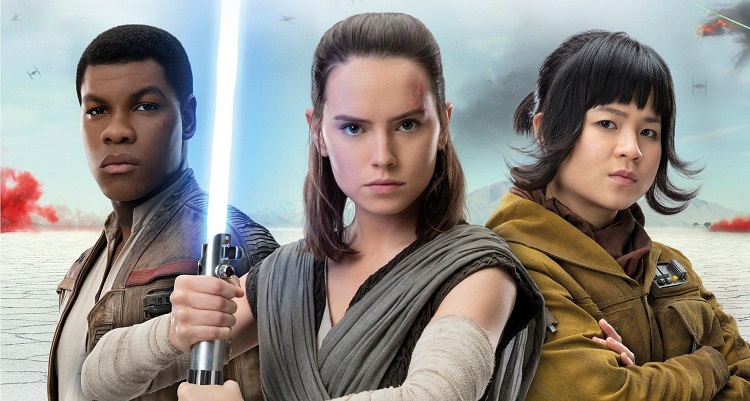 Fans who wanted a Rey movie in The Last Jedi in the same way they watched a movie centered on and driven by Diana in Wonder Woman or Katniss in The Hunger Games series, however, did not get what the marketing had promised. Instead, The Last Jedi is an ensemble movie in which she plays a key heroic role, comparable to Black Widow in Captain America: Civil War or Hermione in the Harry Potter series.
Fans who wanted a Rey movie in The Last Jedi in the same way they watched a movie centered on and driven by Diana in Wonder Woman or Katniss in The Hunger Games series, however, did not get what the marketing had promised. Instead, The Last Jedi is an ensemble movie in which she plays a key heroic role, comparable to Black Widow in Captain America: Civil War or Hermione in the Harry Potter series.
It is true that some indications in The Last Jedi’s marketing pointed in other, more accurate, directions. Unlike the international poster, which featured Rey in the biggest profile spot at the top, the U.S. poster gave Luke the emphasis and placed Rey on the second tier, paired with Kylo Ren. The film’s full-length trailer closed with Kylo’s extended hand to Rey, accurately conveying that her principal character arc in the film is not propelled by her own story by rather is driven by her reaction to the arcs of Luke and Kylo. In the aggregate, though, the movie’s marketing created the clear – and misleading – impression that Rey was the pivotal character in the story like Luke in the Original Trilogy or Anakin in the Prequel Trilogy.
Perhaps the biggest marketing disconnect, though, is the emphasis on Rey paired with the emphasis on Crait. The color red was the theme of The Last Jedi’s marketing from the beginning, including the lettering of “Star Wars” in the title reveal and the 2016 teaser posters from Star Wars Celebration Orlando and D23 Expo. Later, the red-on-white coloring from the Crait battle became prominent on toy packaging and merchandise. And not only the color scheme drew from Crait: so too did the frequently used key art, such as images of ski speeders and AT-M6 walkers on the white salt plains. Yet Rey has essentially no role in the Battle of Crait. In its marketing, Lucasfilm chose to emphasize the imagery of the movie’s climactic final battle – the one between Kylo Ren and Luke, again suggesting that the movie is fundamentally about their conflict, not Rey’s progression.
Just like the disconnect between the marketing of The Force Awakens and the final film, the release of The Last Jedi confirmed that the marketing once again did not align with the movie. And just like two years ago, we are left with questions about how and why such divergence is allowed to occur. Did Lucasfilm crassly capitalize on Rey’s popularity by overselling her as the lead character in the movie to entice her fans to the theater? Or has Lucasfilm convinced itself that Rey is the main character simply because she is the Jedi heroine, regardless of what the story told actually includes? Does Lucasfilm believe the story is really focused on Rey even though it isn’t – or does Lucasfilm know the Sequel Trilogy is really Kylo Ren’s story but is trying to deflect attention from that reality as long as possible? After three years of marketing and the release of two films, fans still do not have the answers to these questions. But we do know, after how The Force Awakens and The Last Jedi were marketed compared to how their stories unfolded, that we cannot take anything in the marketing of Episode IX at face value in its representations of what Rey’s story involves in the trilogy’s concluding chapter.
The Storytelling Dangers of Rey’s “Nobody” Heritage
From its announcement in late 2012, the Sequel Trilogy has been officially described and expressly marketed as the continuation of the Skywalker family saga. Prior to The Force Awakens, many fans rightfully expected that the central hero character would be a member of the Skywalker family, like Luke and Anakin in the previous trilogies. After The Force Awakens failed to definitively and explicitly resolve Rey’s parentage, many fans rightfully expected that the film’s Jedi heroine still could be revealed as a blood relative of the film’s familial villain, Kylo Ren, and they parsed the dialogue and symbolism in the movie for possible clues for how the new trilogy would balance the light and the dark in the Skywalker family as the prior trilogies had done. At the same time, The Force Awakens also presented indications that Rey was not part of the Skywalker clan, but rather a “no one” drawn into the family’s drama. With thematic elements of Star Wars potentially supporting either direction, fans continued to speculate on who Rey is.
The Last Jedi put an end to the ambiguity by revealing Rey, in her own words, to be the child of “nobody” parents. Though it is of course true that nothing is ever inviolably permanent in Star Wars – later stories managed to elide the bisection death of Darth Maul or Leia’s memories of her real mother, for example – the intended meaning of the film, as released in 2017, is clear. The reveal of Rey Random does not contradict The Force Awakens, is internally consistent within The Last Jedi, and aligns with interviews and other public statements by writer-director Rian Johnson. Occam’s Razor makes quick work of the issue: rather than infer an elaborate conspiracy to conceal a surprise twist reveal of Rey’s Skywalker bloodline in Episode IX, the simplest explanation – that The Last Jedi reveals Rey Random – is the correct one.
Yet on its own terms in expressing that point, The Last Jedi is not fair to Rey. When professionals, commentators, or other fans wonder why some fans have made a big deal about Rey’s parentage since The Force Awakens, the easiest explanation is obvious: she doesn’t have a last name. Luke and Anakin did. So did Han, Leia, Lando, Wedge, Padmé, Shmi, Obi-Wan, Qui-Gon, Mace, Jar Jar, Poe, Hux, Unkar, and many more. Though there are exceptions, like Yoda and Chewbacca, prior to Rey no prominent human character – and certainly no white male lead character – had been denied a surname. (Finn lacks a surname too, but otherwise Rey’s name situation would have been transparently hiding something.) Her toy packaging has to say “Rey” or “Rey of Jakku” when every other prominent female character can be “Leia Organa” or “Padmé Amidala,” “Jyn Erso” or “Ahsoka Tano,” “Hera Syndulla” or “Sabine Wren.” Fans rightfully inferred that there must be a storytelling reason behind it. Instead, we later learned that the filmmakers were simply making it up as they went along, and Rey did not have a last name because they hadn’t decided who she is yet.
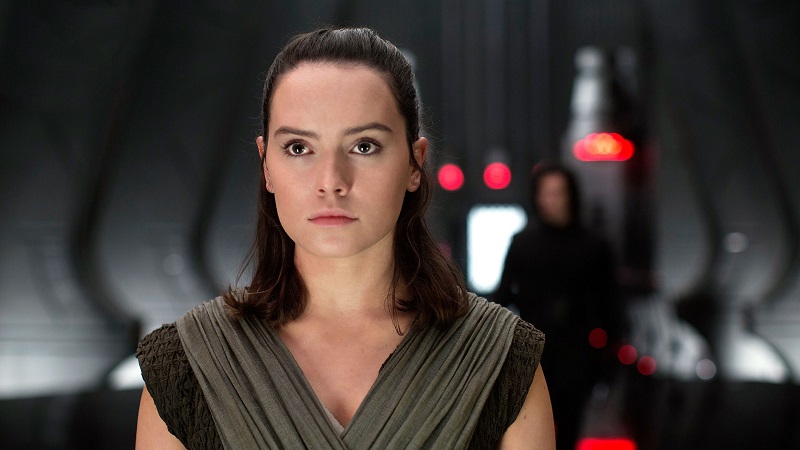 In denying Rey Random the truth of her surname as part of confirming her “nobody” parentage, The Last Jedi fails to give Rey the closure she deserved on a family theme spanning two movies. It is Kylo who first speaks aloud that Rey’s parents are nobodies, in their third ForceTime prior to Rey entering the Mirror Cave. Having learned emotional manipulation at the feet of Snoke, Kylo very well could be lying when he later claims to have seen Rey’s parents when they touched hands in their fourth ForceTime – especially since Rey herself did not see them, yet desperately wanted to. Despite showing the flashback of the fateful night between Luke and Ben three times before reaching the truth, the films shows Rey’s vision in the Mirror Cave is only once; there is no second version to confirm her parents’ faces. Nor is the audience ever shown what Kylo supposedly saw in the Force, either. Crying under his harangue on the Supremacy, Rey verbalizes that her parents were nobodies, but she may be expressing her own fears and insecurities from what she believes to be true – or telling a violent darksider what he wants to hear to keep him from turning his blade against her next. Even accepting the thematic notion that Rey must stand as a Jedi on her own, without a family lineage or powerful bloodline to bolster her claim to heroism, nothing would have been lost by giving Rey a surname to confirm her “nobody” parentage. Even Shmi, a slave, and Owen and Beru, moisture farmers, have last names. Filthy junk traders on Jakku would have one, too. Rey’s greeting with Poe on the Falcon in the film’s epilogue provided the perfect opportunity for Rey to finally admit the truth of her past and use her given surname – but she doesn’t. While The Last Jedi shows Rey close the door on her bond with Kylo Ren, it does not close the door on her heritage. Especially if questions about Rey’s parents for two movies were much ado about nothing, Rey deserved a more definitive resolution.
In denying Rey Random the truth of her surname as part of confirming her “nobody” parentage, The Last Jedi fails to give Rey the closure she deserved on a family theme spanning two movies. It is Kylo who first speaks aloud that Rey’s parents are nobodies, in their third ForceTime prior to Rey entering the Mirror Cave. Having learned emotional manipulation at the feet of Snoke, Kylo very well could be lying when he later claims to have seen Rey’s parents when they touched hands in their fourth ForceTime – especially since Rey herself did not see them, yet desperately wanted to. Despite showing the flashback of the fateful night between Luke and Ben three times before reaching the truth, the films shows Rey’s vision in the Mirror Cave is only once; there is no second version to confirm her parents’ faces. Nor is the audience ever shown what Kylo supposedly saw in the Force, either. Crying under his harangue on the Supremacy, Rey verbalizes that her parents were nobodies, but she may be expressing her own fears and insecurities from what she believes to be true – or telling a violent darksider what he wants to hear to keep him from turning his blade against her next. Even accepting the thematic notion that Rey must stand as a Jedi on her own, without a family lineage or powerful bloodline to bolster her claim to heroism, nothing would have been lost by giving Rey a surname to confirm her “nobody” parentage. Even Shmi, a slave, and Owen and Beru, moisture farmers, have last names. Filthy junk traders on Jakku would have one, too. Rey’s greeting with Poe on the Falcon in the film’s epilogue provided the perfect opportunity for Rey to finally admit the truth of her past and use her given surname – but she doesn’t. While The Last Jedi shows Rey close the door on her bond with Kylo Ren, it does not close the door on her heritage. Especially if questions about Rey’s parents for two movies were much ado about nothing, Rey deserved a more definitive resolution.
Even more important than the flaws in the manner by which Rey’s parentage was revealed is the grave danger presented by that storytelling choice: that Rey’s story will be sidelined again in Episode IX to serve the resolution of the Skywalker saga storyline centered around the only next-generation family heir in the story, Kylo Ren. This risk would be far lower for a dynastic heroine, Rey Solo, set up for a sister/brother showdown over the family’s legacy in the galaxy. Instead, Rey Random is an interloper in the family drama, which explains why her story arc in The Last Jedi is built in response to Luke and Kylo rather than defined by motivations and objectives of her own.
In fact, The Last Jedi not only denies Rey agency in the flow of her own plot, but also denies her agency in her destiny. Both Snoke and Luke validate the symbolism that Rey’s empowerment in the Force exists only because of the imbalance created by Kylo Ren: darkness rises and light to meet it; powerful light and powerful darkness in balance on the island. Rey is not a strong Jedi because she chooses to be one – overcoming the tragedies and failures of three generations of men in her family to become the Skywalker Jedi heroine Leia’s story was denied by the men who wrote her tales – but rather because the Force has designated her to rise in strength in the light to balance Kylo’s power in the dark. This further explains why Rey is not the center of the story and Kylo is: he is the Skywalker in the Skywalker family story, and she is the Kenobi who must step in to put down the family villain.
Speaking Up Is Even More Important After The Last Jedi
In addition to the troubling prospects presented by The Last Jedi within the terms of the movie, the recent disclosures about the Sequel Trilogy’s production process only exacerbate the risks for the future of Rey’s story. In his appearance on the /Filmcast, Rian Johnson admitted that the filmmakers are making up the story as they go, including the foundational decision about Rey’s parentage. The absence of a thoughtful plan for the story creates an enormous danger that a misguided choice will be made on the fly – and that it will be locked into the story before the error is identified, such as when a subsequent storyteller realizes the full ramifications, instead of being caught in time to correct or adjust it. Johnson’s admission also confirms accounts that Lucasfilm is hiring directors and writers, delegating the story crafting to them, and then approving or modifying what they pitch – rather than making fundamental storytelling decisions for the central characters of Star Wars by a storytelling brain trust serving as stewards of the franchise, who take part in collaborative deliberation and analysis with vigorous debate and full consideration of all alternatives. With no storytelling plan and minimal storytelling oversight, the prospect of a major failure for Rey in Episode IX is real.
As noted at the beginning of this post, plenty of time remains before the story of Episode IX is irreversibly finalized. Both The Force Awakens and The Last Jedi demonstrate how easy it is for the men writing the third trilogy of the Skywalker family saga to sideline Rey Random in service of the key developments in the story of Kylo Ren. Especially if Leia is written out of Episode IX, the Skywalker saga’s conclusion will be Kylo’s tale alone – only increasing the likelihood that Rey’s role in the story could become subservient to his. If Rey is truly meant to be the central hero of the Sequel Trilogy, then it is crucial for fans to continue speaking up on her behalf, holding Lucasfilm accountable to her character’s potential.
.
Related Links
- Rey At Risk: Keeping Lucasfilm Accountable to Her Potential (Feb. 2016)
- Leia At Risk: Grief, Nostalgia, and Mythic Storytelling (Jan. 2017)
- Why We Support Recasting General Organa (Apr. 2017)
- The Last Jedi’s Unexpected Star Wars Story Structure
- Leia Organa: Leader of the New Jedi Order
- The Problems With Rey Random: A Storytelling Analysis
- The Last Jedi and the Hero’s Journey – Part One: Rey
- Leia At Risk Revisited: The Stakes After The Last Jedi
- Skywalker At Risk: Serial Storytelling and Brand Value

